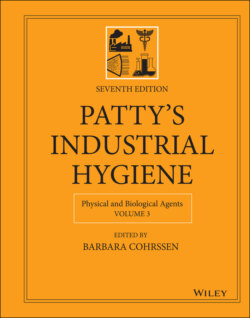Читать книгу Patty's Industrial Hygiene, Physical and Biological Agents - Группа авторов - Страница 141
6.3 Photocuring of Coatings in Manufacturing
ОглавлениеSeveral regions of the optical radiation spectrum have been used in manufacturing for drying and curing coatings and other materials.
In the powder coating process, an alternative to solvent‐based painting or finishing, pigment in a resin powder matrix is deposited on the substrate by electrostatic attraction and heat is then used to melt the powder so that it forms a smooth, solid layer. IR lamps or ovens are often used as the heat source for the melting process.
Photocuring processes that produce cross‐linking in polymers require higher quantum energies and thus a much shorter wavelength, typically in the UV region. UV‐A is the most commonly used wavelength band for photocuring. However, xenon lamps, mercury‐vapor lamps, and metal halide lamps used for high‐powered photocuring may also emit UV‐B and UV‐C radiation. High‐power lamps for photocuring are typically enclosed in opaque housings, but stray radiation may still exceed exposure limits for UV radiation (80). There is also a potential blue‐light hazard if the source is viewed. In the case of pulsed xenon photocuring systems, the risk of retinal thermal damage should also be evaluated. Enclosures should be designed with minimal openings. Direct light from the source should not be visible to the operator or other personnel. Reflected light should be minimized by painting surfaces with black matte paint. Because ozone may be generated by UV‐C radiation, source enclosures should be ventilated to the outside. Workers should wear eye and skin protection for UV. Electrical safety and excess heat are additional concerns due to the power requirements of these photocuring systems.
Photocuring systems that use ultraviolet light‐emitting diode (ULED) technology are also available. ULEDs emit radiation in a relatively narrow band, for instance 380–420 nm, eliminating the risk of ozone generation and exposure to UV‐B and UV‐C radiation. ULED photocuring sources might still produce high UV‐A irradiances of about 1 W cm−2, sufficient to cause overexposure in a few seconds or minutes. Blue‐light exposure could also be a hazard if the source is viewed. Potentially exposed skin and eyes should be protected.
